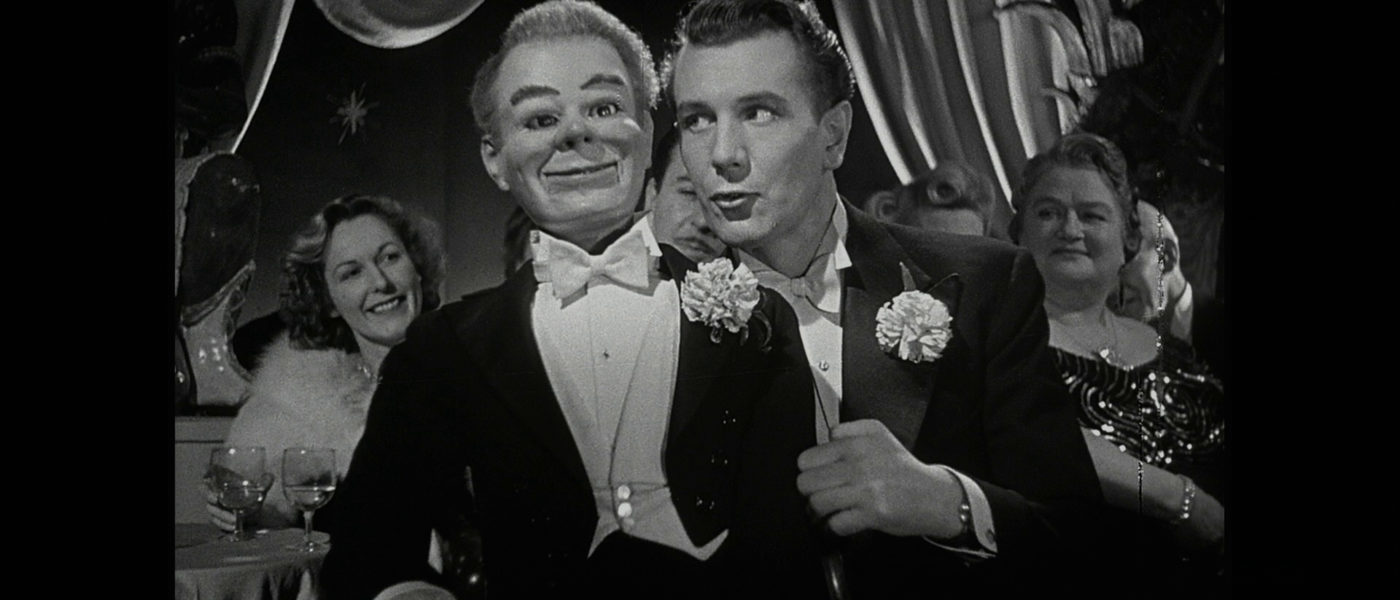Influential British Horror In Five Eternally Looping Segments
1945/DIRECTED BY [ALBERTO] CAVALCANTI, ROBERT HAMER, CHARLES CHRICHTON & BASIL DEARDEN
STREET DATE: JULY 9TH, 2019/KINO LORBER STUDIO CLASSICS
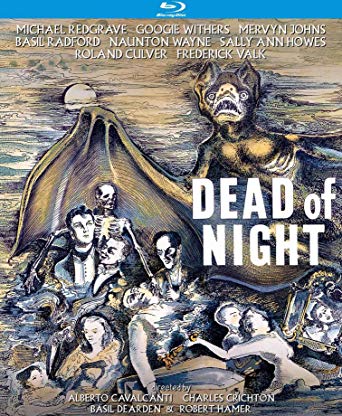
Announcing its midnight atmosphere from its title, Ealing Studios in their horror-anthology film Dead of Night addressed fear, dread, and terror with the same wit and precision with which they would later imbue their bright, clever comedies of postwar Britain. Joining five very different tales of the supernatural with an ingenious framing device — whose nightmare-like associations linger well after the film’s closing credits (and which, parenthetically, offer a compelling story-argument for future re-watchings) — screenwriters John Baines and Angus MacPhail, with an uncredited dialogue assist from the talented T.E.B. Clarke, drew on a tradition of British horror that had been little seen on screens to that point in British film, but which had sent shivers down the spines of Victorian readers in the pages of popular dark fantasists like M.R. James, Algernon Blackwood, and Arthur Machen.
Blurring the boundaries between the real and imagined, the commonplace and the uncanny, and the everyday and extraordinary, the intrusion of unknown, malevolent forces on our waking world proved a singular approach that was at once psychological in effect and mythical in scope. For its first film audiences, precisely one month after the end of war in Europe, four directors, three writers, and a dedicated company of studio performers and technicians — under the auspices of innovative producer and British film mogul Michael Balcon — collaboratively crafted haunting visions of eternity, and its mortal opposite, from the Dead of Night.
Casting its modernistic shadows on the nineteenth century ghost story, Dead of Night broke with more classical modes of horror movie storytelling, popularized by Hollywood’s Universal Studios’ Depression-era run of historically displaced “fright films” (i.e., Dracula [1930] and Frankenstein [1931]), for less remote and more up-to-the-minute tales of terror drawn from present-day realities. Like the contemporary (and often contemporary-set) horror films of RKO producer Val Lewton, whose films ranging from Cat People
(1942) and The Seventh Victim (1943) also used atmosphere and psychology to suggest inner tension and outer unease, Dead of Night invests each brush of the supernatural with a level of initial familiarity that at once plunges into the realm of the unexplained. A hospital stay, a children’s party, a marital courtship, a sporting and romantic rivalry, and — most alarmingly — a talented performer’s divided nature; all are stories embedded within a building contractor’s professional visit to an idyllic country house which may be the dreams-and-reality nexus between our world and oblivion.
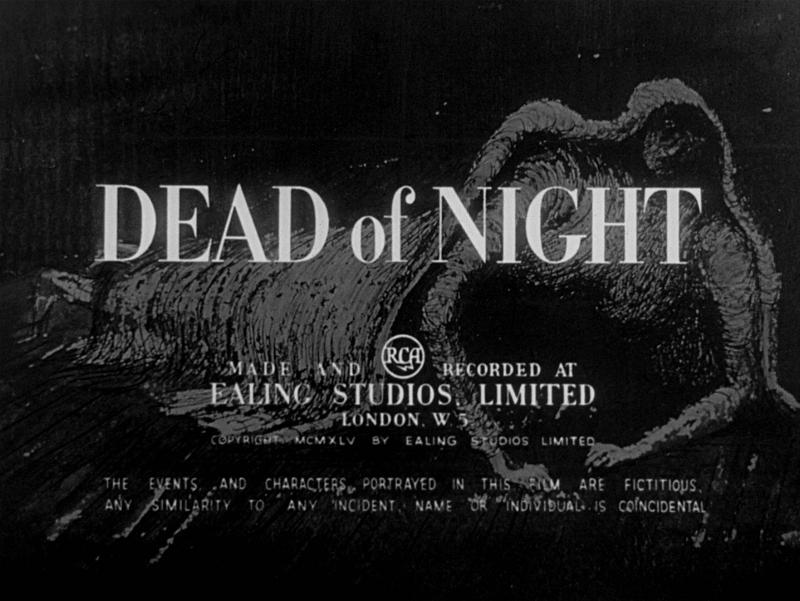
“Pilgrim’s Farm” (dir. Basil Dearden)
The title for the film’s untitled prologue, connecting, and concluding material derives from the story-framed gathering at a stately rural manor. “Pilgrim’s Farm”, denoting the locale’s thematic connection to a tradition of English storytelling stretching clear back to the late fourteenth century — when Geoffrey Chaucer’s Canterbury Tales followed a diverse group of travelers telling stories on holy pilgrimage — opens on a Londoner named Walter Craig (Mervyn Johns), whose sleepwalking manner and instinctual behavior suggest an eerie familiarity with the house and its motley assembly of guests. Anticipating upon being greeted by the house’s owner (Roland Culver) the location of a hidden alcove past the front door, and then moving through the old house towards the central drawing room as if he had been there before — despite it being his first visit — Mr. Craig soon disrupts a light-hearted afternoon tea in progress with a mood-darkening foreknowledge of events to come. The unexpected arrival of a brunette woman short of cash, the accidental breaking of someone’s glasses, a savage slapping of an unoffending teenage girl; these future images, reflected through the dark mirror of a dreamer’s disconnected “remembrance”, inspire five similarly unexplained occurrences related in turn by Pilgrim’s Farm’s last(?) inhabitants.
Weaving in and out of the film with a dramatic dexterity bordering on invisibility, the thematic integration of its spooky premise to the differing personality of each segment — literally dramatizing each of Pilgrim’s Farm’s characters with a character-fitting tale — provides Dead of Night with a cohesion that may resist an attempt to adequately describe it. Suffice it to say, however, the purposeful sense of déjà vu, and the resulting suspense of how each of Mr. Craig’s premonitions will come true, or where they will fit in the unfolding story-arch, proves unusually effective in carrying the viewer through each succeeding episode.
“The Hearse Driver” (dir. Basil Dearden)
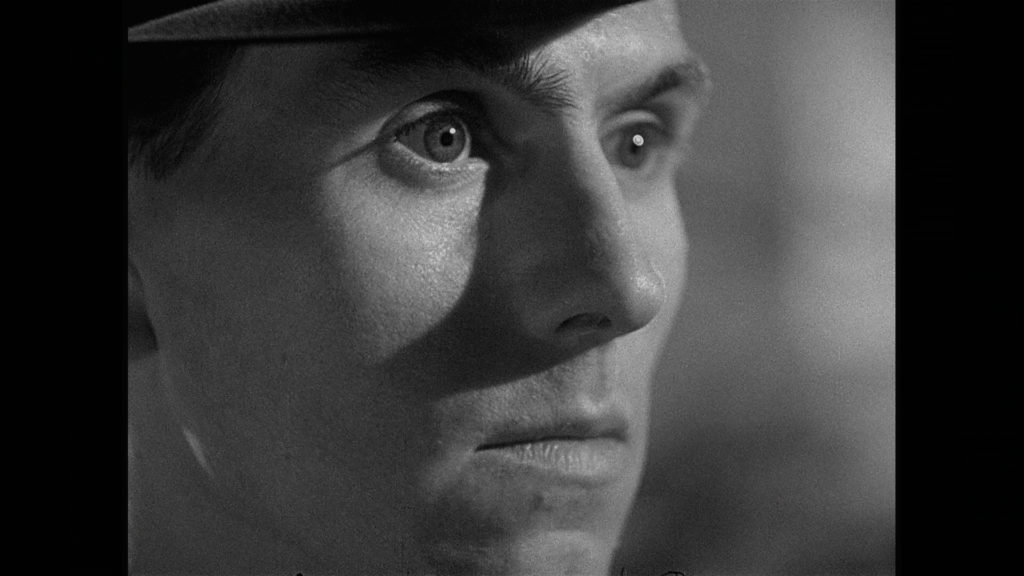
Directed, like the framing story, by Basil Dearden, “The Hearse Driver” is one of two stories in Dead of Night based directly on preexisting source material. Adapted from E.F. Benson’s 1906 story “The Bus-Conductor”, the segment is told by Pilgrim’s Farm guest Hugh Grainger (Anthony Baird), a stock-car racer who relates the circumstances of a disconcerting hospital stay, and subsequent warning of death, following his narrow survival and slow recovery from a racing “crack-up”.
One evening during his stay, Grainger awakes to find that a day-and-a-half has elapsed since he glanced at his bedside clock — the close of visiting hours having seconds later become ominously pointed at “4:15”. Slowly rising and walking through the curiously still room — all ambient noise shut off except the sounds of his shuffling feet — Grainger pauses at the closed drapes before quickly drawing the window open.
Switching to a view of Grainger framed by the window from the outside, the viewer and patient are suddenly thrust into the no-time shade of neither night nor day, the chirruping of birds unexpectedly filling the soundtrack, but in no way imparting the sonic comfort they might otherwise provide to a similar window view. Looking down to a street curiously empty of traffic, bleached charnel white in its monochrome view, a lone, horse-drawn hearse draws next to the curb, its driver (familiar comic character actor Miles Malleson) looks up to the window — tightening to a close-up of his far from reassuring features — and fearfully intones, “Room for one more, sir!”
More anecdote than story, perhaps, “The Hearse Driver” nevertheless sets a chilling tone for what will follow, its concluding image of a bus-full of passengers plunging to their deaths off a collapsing bridge — a fate again narrowly avoided by the protagonist — rendered all the more shocking by a similarly unreassuring close-up of Grainger’s anguished features. Without directly referencing the national trauma of wartime death and destruction, “The Hearse Driver” captures the real-life dread of sudden violence and uncertain mortality in haunting, supernatural terms.
“The Christmas Story” (directed by [Alberto] Cavalcanti)
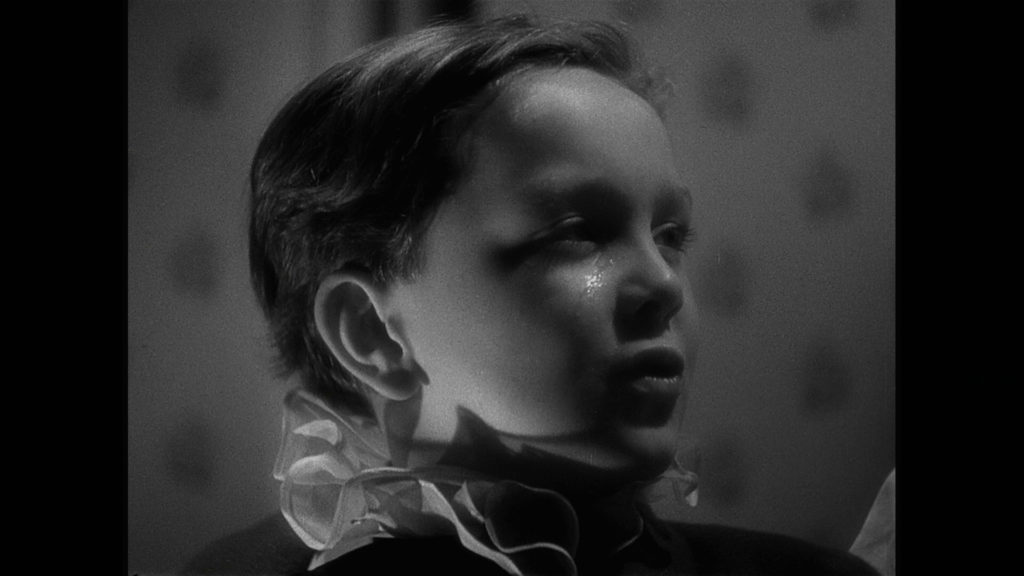
As its title might suggest, the “lighter” of the two opening stories, “The Christmas Story”, written by Angus MacPhail, finds initial relief from the previous tale of bizarre premonitions and mass death with the charming British customs of children’s games, masquerades, and decorations surrounding Yuletide celebration. Told by precocious teen chatterer Sally O’Hara (Sally Ann Howes), whose distracted mother (Barbara Leake) quickly whisks the child off home after relating her story, “The Christmas Story” contains one of the more disturbing backstories of any of the tales comprising Dead of Night.
Bored with the game of hide-and-seek she is playing with the smaller children during the Christmas revels at a Victorian mansion, where the party takes place, Sally and the older son of the residing family, Jimmy Watson (Michael Allan), steal up the grand house’s equally grand stairs landing to its upper stories, and eventually its vast attics — filled to dusty brim with chests, furniture, and curiosities left over from previous owners. In that appropriately spooky setting, Jimmy relates the story of the house’s original owners, whose youngest child was the shocking victim of sibling rivalry gone horrifically wrong, the child’s older sister having jealously and rather determinedly dispatched the doted-upon innocent one holiday evening in singularly gruesome and savagely meticulous fashion.
This awkward attempt at adolescent courtship by telling a grisly episode of Victorian terror decidedly failing, Sally wanders off on her own before coming on a charmingly old-fashioned child’s bedroom and a solitary boy named Francis Kent, who has been left to celebrate the holiday by himself due to an angry older sister named Constance. The viewer will be ahead of the character on this story’s “twist”, but the real-life dimensions to this tale may prove resonant beyond the admittedly creepy “resurrection” — or at least the postmortem spiritual visitation — of a dead child: in one of the most infamous passages from the annals of Victorian true crime, the confession of sixteen-year-old Constance Kent to the murder and dismemberment of her four-year-old half-brother, Francis. After serving a jail term and changing her name, the convicted murderess eventually emigrated to Australia where she died in 1944 at the age of 100, one year before the premiere of Dead of Night.
“The Haunted Mirror” (dir. Robert Hamer)
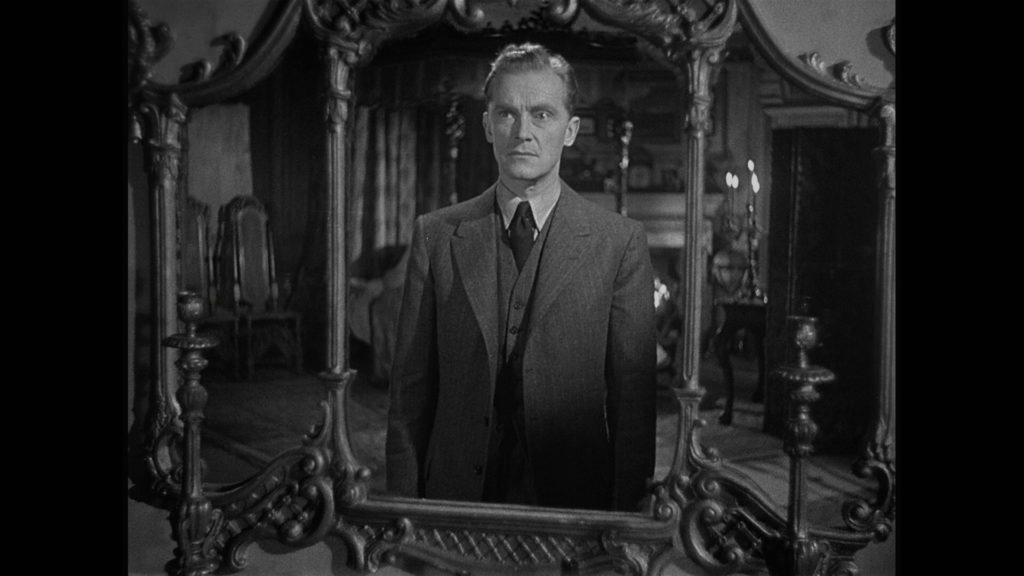
Elegant woman of fashion Joan Cortland, played by the always delightful Googie Withers, takes center stage in Pilgrim’s Farm’s next ghost tale, the story of her engagement and marriage supernaturally compromised, to brilliant effect, by the title antique. Devised by screenwriter John Baines, and directed to equally vivid effect by Robert Hamer, “The Haunted Mirror” is again inspired by the work of E.F. Benson — the dark fantasy author, incidentally, who had the most influence on Dead of Night’s peculiarly involving brand of psychological horror.
“The Haunted Mirror” commences with the engaged Joan in a whirlwind of activity in both planning her marriage to and her subsequent shared life with cultured bon vivant Peter Cortland (Ralph Michael). Joan’s engagement and housewarming gift to Peter is, of course, the “new” dressing mirror; which, with its pattern wood-carved and triple-paneled frame, appears strangely out of keeping, as an impossibly ornate relic of early nineteenth century masculinity, with the stream-lined and modernistic design of Peter’s tastefully appointed bedroom. So much so, in fact, that upon Peter’s first blinking glimpses into the mirror, he somehow imagines himself within its reflected space, standing inside a very different room with a four-poster bed, heavy oak paneling, dark fur rugs, hanging hunting trophies, and a deep roaring fireplace.
Uneasily settling into married life, Peter’s mirrored visions increase to the point where the inhibited, reserved man is unable to see his reflection without also seeing that terrifying room. Infecting his personality, as well as his conflicted relationship with Joan, Peter soon becomes the character of that reflected room; the shadow of jealousy, possessiveness, and — dareonesay? — toxic masculinity, in our 21st century-update of male chauvinism, casting its old country lodge-like cruelty on Peter’s impressionable spirit.
With its suggestive symbolic layers and unusually resonant themes, addressing the effect and change of personality upon marriage, the horror slowly builds in the Cortland’s domestic sphere, especially as it applies to an uneasy sexual relationship, creating a palpable sense of dread in the viewer imagining him or herself in that mirrored world of savagery past. A privileged view, perhaps, until Joan sees herself in the reflection of that world, while Peter is ferociously engaged in choking the life from her. As one can further imagine, or might quickly infer, with the mirror standing in mocking terror before this violent scene, there is but one way to break its spirit-controlling spell.
“The Golfer’s Story” (dir. Charles Crichton)
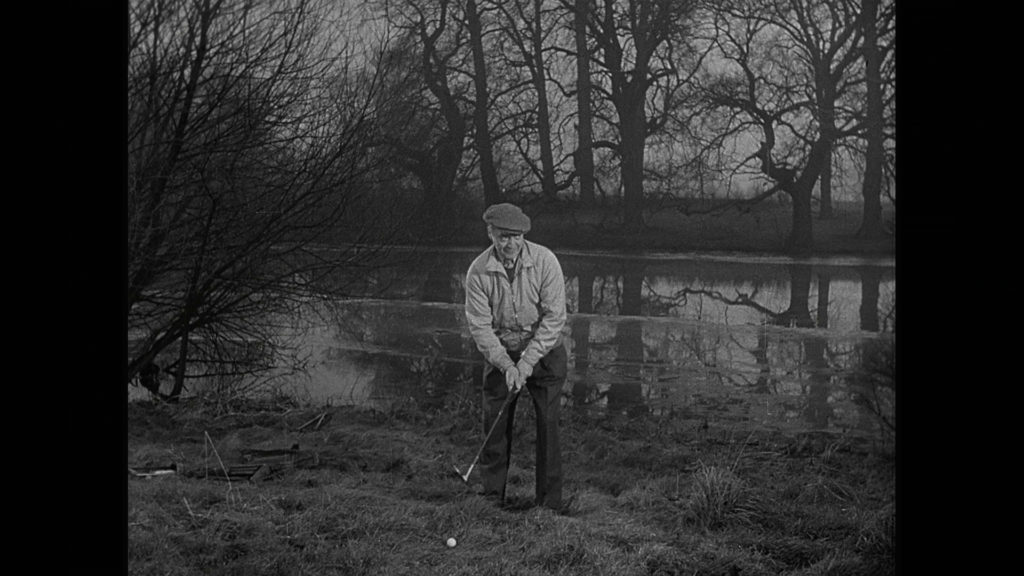
Adapted from H.G. Wells’ 1902 “The Story of the Inexperienced Ghost”, director Charles Crichton — best known for the types of ingenious comedies, beginning with Hue and Cry (1947) and continuing through later work such as The Lavender Hill Mob (1951) and The Titfield Thunderbolt (1953), for which Ealing Studios became most famous in the postwar era — offers a pressure relief from the dramatic heaviness of the previous segment with, here, the ghost story equivalent of a bawdy joke. Along with “The Christmas Story”, “The Golfer’s Story” is one of two segments cut from the original U.S. release — either because, as in the case of the previous Christmas tale, of its perceived slightness, or more likely, in the case of the golfer’s competition, due to its frank sexual content — but by itself, and taken on its own merits, proves one of the more purely entertaining segments from Dead of Night (as well as a dramatic calm before the storm of its next and final segment, “The Ventriloquist’s Dummy”).
As told by Eliot Foley (Roland Culver), the Pilgrim’s Farm owner reveals himself as an idling sporting clubman drawn from the comic mould of P.G. Wodehouse in his highly dubious re-telling of the sporting and romantic rivalry of fellow golf club members George Paratt (Basil Radford) and Larry Potter (Naunton Wayne). Reviving their comic two-act as the unflappably frivolous sports enthusiasts and unlikely international adventurers Charters and Caldicott, a popular pairing which commenced with Alfred Hitchcock’s The Lady Vanishes (1938), continued through Carol Reed’s Night Train to Munich (1940), and even earned them their own starring feature, in 1941’s Crook’s Tour, Basil Radford and Naunton Wayne’s similarly indistinguishable Parratt and Potter vie for the affection of fair Mary Lee (Peggy Bryan) — and it almost certainly doesn’t matter whom is the precise victor. (Or, indeed, that sporting matters clearly supersede romantic interests.)
A golfing contest for (the mainly indifferent) Mary’s hand, Parratt’s cheating (yet sportingly “honorable”) victory, and Potter’s fully dressed (and golfing-equipped) pond suicide later, the latter’s wronged spirit is soon haunting the former’s upcoming nuptials — up-to-and-approaching the married couple’s honeymoon bed. The inexperienced ghost of Mr. Wells’ original title finds himself awkwardly connected by an invisible ectoplasmic bond of six feet, unable to tactfully (or tastefully) spiritually disappear, a forgotten sequence of hand gestures preventing poor Potter from shuffling this mortal coil safely (and decently) back to the land of the dead.
The “punchline”, telegraphed with the broadness of the living Parratt unwittingly discovering the correct magic signal before the dead Potter, has again to do with how little it matters between these ineffectual ditherers who precisely occupies the marital (and sexual) role, but the sequence’s central image of Potter slowly descending into the sinking moat past the course’s eighteenth hole, the frighteningly-composed shot held wide and long to the pond-swallowed ex-golfer’s final rising air bubble, may linger in the viewing memory well past “The Golfer’s Story”’s several chuckles and guffaws.
Structurally, as Dead of Night’s penultimate tale, this veddy veddy British passage of comic relief leaves viewers (and auditors) subsequently vulnerable to the decidedly un-comic vocal attack of…
“The Ventriloquist’s Dummy” (dir. [Alberto] Cavalcanti)
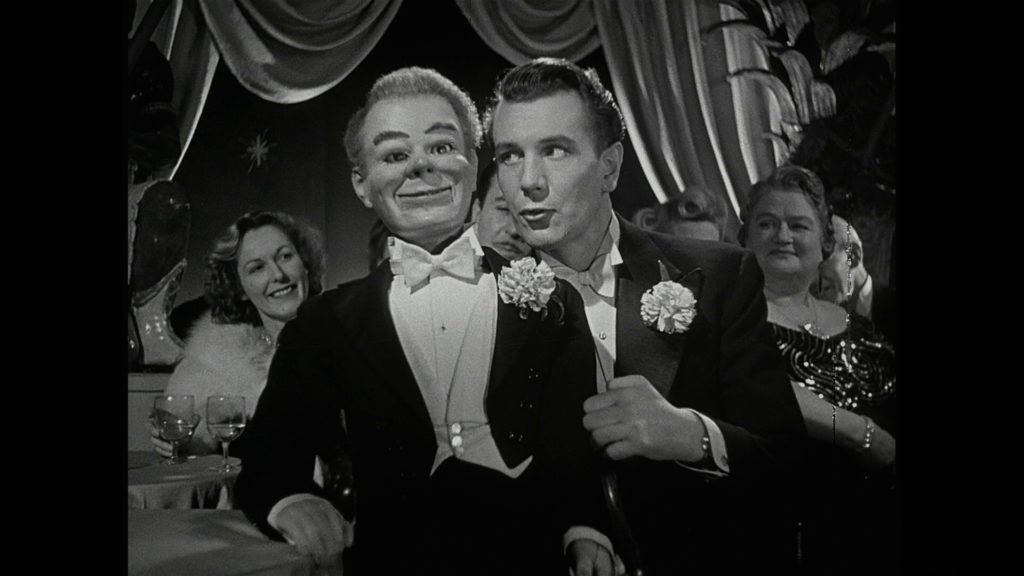
And so at long last we come to the concluding tale of Dead of Night, whose dark brilliance remains undimmed (or, as it were, atmospherically underlit) across nearly 75 years of subsequent horror movies. Finding a bottomless reservoir of nightmare associations in the performative and personal rivalry of a ventriloquist and his dummy, which is all the more terrifying for how absurd such a description might look in print, director Cavalcanti and actor Michael Redgrave, from a story by John Baines, memorably dissect this tortured relationship between art and expression, expression and repression, repression and violence.
And that VOICE! As this reviewer was recently reminded in reviewing an unrelated movie that similarly explores the terror of disguised speech, the clacking, painted lips of an overdressed piece of cut pine may still prove heartstopping — as hollow eyes swivel on a wired neck, to deliver piping mortal threats at a point just above the barely vibrating vocal cords of the life-imbued object’s own physical manipulator.
Related in stentorian tones by Pilgrim’s Farm’s visiting Dr. van Straaten (Frederick Valk), whose heavy accent, thick glasses, and patrician manner as the traditional image of the Freudian analyst stops just short of the pointy little beard, “The Ventriloquist’s Dummy” concerns talented but tortured cabaret performer Maxwell Frere (Redgrave), who as the story opens is headlining a trendy nightspot in Paris, France with his irrepressible wooden companion, Hugo Fitch.
Visited by fellow ventriloquist Sylvester Kee (Hartley Power) one performance, Maxwell-as-Hugo — or, as the story soon suggests, the reversal of that personality configuration —begins an at least initially joking “seduction” of Mr. Kee’s superior talent as a performer that soon threatens to “break up” the established two-act of Fitch & Frere. The terrifying implications of that impossible division deepens into homicidal jealousy and irretrievable schizoid insanity when the declining Maxwell (or Hugo himself?) makes a violent attempt on the life of Sylvester Kee.
From The Great Gabbo (1929) to The Devil Doll (1964) up through 1978’s Magic, with numerous episodes of The Twilight Zone in between, the murderous conflict embedded in the divided personality of the ventriloquist figure has proved a practically deathless horror film trope. But Dead of Night’s “The Ventriloquist’s Dummy”, which directly influenced many of its later portrayals, retains an unusual power beyond its premise, its shadow-soaked atmosphere — courtesy of lighting cameraman Douglas Slocombe — and more particularly actor Michael Redgrave himself — with his own layers of sexual ambiguity and professional insecurity — enacting the true horrors of a mind in conflict with itself as complicated by the world of show business and entertainment.
When Frere is reunited with Fitch in his cell, the illusion of life’s stage is complete with Frere’s savage attack on his alter ego sending its high-pitched death-throes echoing through the prison. In that moment, and not to fully reveal the end-sequence’s truly shocking bed-side role (and voice) reversal, the jailer, van Straaten, and we the viewer are entirely taken in by the horrifying “reality” of a not-so-inanimate object imprinted psychologically, symbolically, and — as it may turn out — supernaturally with the tormented personality of an artist who has destroyed himself with his own art.
“Epilogue” (dir. Basil Dearden)
Returning to Pilgrim’s Farm, Dead of Night definitively blurs its narrative, thematic, and stylistic boundaries between dreams and reality in a bravura stories-summation which might best be titled “Phantasmagoria”. Directly after hearing the singularly distressing break-up of Frere & Fitch, the psychological break for Mr. Craig occurs when the most immediately suggestive of his oneiric premonitions — the breaking of Dr. van Straaten’s glasses — sends the formerly mild-mannered and sedate story-auditor into a sleepwalking, murderous rage. Dismissing the other guests for the evening, Craig promptly dispatches van Straaten in a style familiar, although this time successfully, to the near-fatal conclusion of “The Haunted Mirror”.
Craig’s descent into madness(?), dream(?), or the realm of the supernatural complete, the ghost-dreamer is forced to re-experience each of the stories in a funhouse mash-up of distorted refraction. Chasing Sally O’Hara up the mansion stairs to the Victorian-furnished attic one moment — where the truly shocking assault of his prediction finally occurs — to sharing visual time with Peter Cortland in the clotheshorse’s antique mirror the next, the dream’s final passage finds Mr. Craig locked in Maxwell Frere’s jail cell by the Hearse Driver (Miles Malleson) himself with a perspective-distorted, disturbingly life-like version of the Ventriloquist’s Dummy. In one of the most frightening images in horror movies bar none, Hugo turns to the camera/Craig/us, rises on his wooden legs, and proceeds with Dead of Night’s third and final choking…
Awakening to the safety of his own bed back in his London flat, gasping for air after a “bad dream”, Craig is soon handed a phone call summoning him to, you guessed it, Pilgrim’s Farm.
Inspired by E.F. Benson’s 1912 story “The Room in the Tower”, and contemporary with similar frightening themes found in the emerging fiction of Jorge Luis Borges, the recurring nightmare of Dead of Night plays against the background of a world itself attempting to emerge from the nightmare of wartime devastation. Hugh Grainger, Peter Cortland, Maxwell Frere, and the dreamer himself, Walter Craig, while never directly addressing the recurring pain, loss, and destruction of war, might nevertheless echo James Joyce in his early twentieth century pronouncement of “History” as a “nightmare from which I am trying to awake.” Dramatizing the nationally traumatic with the personal and psychological, Dead of Night remains resonant as a film nightmare from whose legacy it might be similarly difficult to escape.
…
And nor would we want to. As the closing credits roll over the replay of the film’s opening moments, showing dazed Walter Craig’s car and country road approach on what may now appear to us as a sinister embarkation point between fragile dimensions, special mention should be made of Kino Lorber’s Blu-ray of Dead of Night, featuring a new 4K restoration and digital upgrade of this important postwar horror feature-anthology film. Inviting an almost immediate rewatch, if one dares, by its very dramatic structure, the crystal-clear imagery restored on this upgrade, while occasionally retaining vertical wear lines and minor blotches throughout, presumably from its source material, will certainly inspire future viewing re-visits possibly equal to Mr. Craig’s recurring dreams.
In addition to a film-length documentary entitled Remembering Dead of Night, which features an impressive talking-head collection of commentators — critics, scholars, and directors — reflecting on the legacy of this influential horror anthology, KLSC’s Blu-ray also includes a characteristically informative audio commentary by Tim Lucas. Balancing a lengthy inventory of the film’s artistic and technical personnel against an analytic reading/viewing of the film — in addition to contextualizing Dead of Night’s unique historical position within the British film industry and its profound influence on subsequent horror films — Lucas deep-dives into the many layers of this many-layered film, teasing out its symbolic and associative powers in a thematically appropriate approach to its considerably effective surface and artistic properties.
An anthology film by its very nature is often either the diminished sum of its parts or the selective parts of its whole. As a model of brilliant storytelling within the format, weaving its varied strands into a cohesive whole, Dead of Night will undoubtedly gain power equal to its built-in and cunningly constructed repetitions. The mirror of our souls may be symbolically broken each time we see our own reflection in it, but its Dead of Night power will forever call us back.
All images are credited to DVDBeaver. Thanks to Kino Lorber for providing a review copy.


